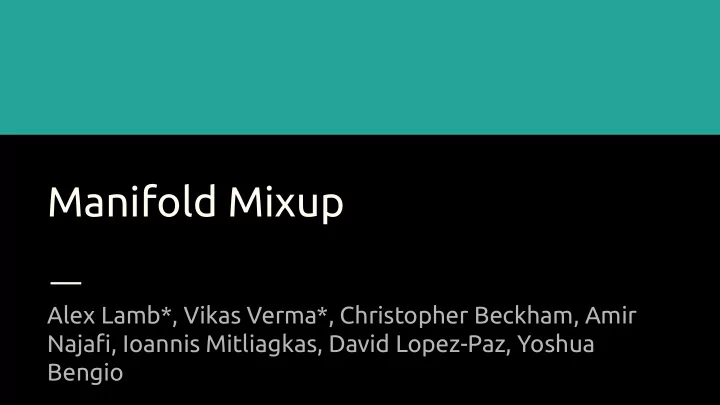

Manifold Mixup Alex Lamb*, Vikas Verma*, Christopher Beckham, Amir Najafi, Ioannis Mitliagkas, David Lopez-Paz, Yoshua Bengio
Troubling Properties of Deep Networks
Issues with Current Methods ● Real data points occupy large volume in the space ● Decision boundary is close to the data ● Data points from off the manifold occupy region overlapping with real data points
Improving Representations with Manifold Mixup Simple Algorithm - just a few lines of code ● ● Great Results Surprising Properties - backed by rigorous theory ●
Manifold Mixup - Simple Algorithm ● On each update, select a random layer uniformly (including the input). Sample 𝜇 ~ Beta( ⍺ , ⍺ ) ● Mix between two random examples from the minibatch at the selected ● layer with weights 𝜇 and (1- 𝜇 ). ● Mix the labels for those two examples in the same way to construct a soft target, yielding the manifold mixup loss , which compares the soft target with the output obtained with the mixed layer.
Manifold Mixup - Great Results Massive gains on likelihood Also works on SVHN, Tiny-Imagenet, Imagenet
Manifold Mixup - Great Results (external) ● Other labs have gotten great results with Manifold Mixup ● Handwriting Recognition (Moysset and Massina, ICDAR 2019) ● Convnets without Batch Normalization (Defazio & Bottou 2018) ● Prostate Cancer Segmentation with U-Net (Jung 2019)
Manifold Mixup - Surprising Properties Data Space Hidden Space
Manifold Mixup - Theory Justifying Properties ● When the manifold mixup loss is perfectly satisfied on a layer, the rest of the network becomes an implicit linear model, which we can call A. This can only be satisfied when dim(H) >= d - 1. ● ● The representations H have dim(H) - d + 1 degrees of freedom. Implications: fitting the manifold mixup objective exactly is feasible in later ● layers, and concentrates the representations such that they have zero measure.
What can Manifold Mixup do for you (applied)? ● Massively improved likelihood, so any classification task where you use the probabilities will probably be helped. Tasks with small amounts of labeled data ● ● May also help with outliers / out-of-distribution, but needs to be studied more
What can you do for Manifold Mixup (theory)? ● Our theory makes very precise assumptions, can these be relaxed? ● Is there a way to generalize mixing to multiple layers or to RNNs (and understand it)? ● Lots of broader work on spectral properties of learned representations: “An analytic theory of generalization dynamics and transfer learning in deep linear ○ networks” (Lampinen and Ganguli 2019) ● Would be great to explicitly connect to Manifold Mixup!
Questions? ● Also if you have any questions, are curious about applying Manifold Mixup, or want to collaborate, reach out to: vikasverma.iitm@gmail.com ○ ○ lambalex@iro.umontreal.ca
Recommend
More recommend